Field Scale Assessment of the TsHARP Technique for Thermal Sharpening of MODIS Satellite Images Using VENµS and Sentinel-2-Derived NDVI
Abstract
1. Introduction
2. Materials and Methods
2.1. Study Sites
2.2. Satellite Images Acquisition and Processing
2.3. TsHARP Methodology
2.4. TsHARP Validation and Assessment
3. Results and Discussion
3.1. Scene Scale
3.1.1. Sensors’ Comparison at Coarse Resolution
3.1.2. TsHARP Validation
3.1.3. TsHARP Validation Comparison between VENµS and Sentinel-2
3.2. Field Scale
3.2.1. MODIS/Sentinel-2 TsHARP Validation
3.2.2. MODIS/VENµS TsHARP Validation
3.2.3. Effects of In-Field Land Cover Variability on TsHARP Performance
4. Conclusions
Author Contributions
Funding
Acknowledgments
Conflicts of Interest
Appendix A. Coordinates and Area of All Fields Selected for This Study
| Location | Field ID | Coordinates | Area (ha) |
|---|---|---|---|
| Miller County, Georgia (scene 1) | 1 | 31°11′53″N, 84°45′45″W | 63.03 |
| 2 | 31°13′3″N, 84°35′2″W | 26.21 | |
| 3 | 31°05′55″N, 84°43′27″W | 164.40 | |
| 4 | 31°06′37″N, 84°43′35″W | 78.93 | |
| 5 | 31°08′31″N, 84°36′01″W | 88.44 | |
| 6 | 31°07′06″N, 84°45′34″W | 33.14 | |
| 7 | 31°07′50″N, 84°52′26″W | 32.30 | |
| 8 | 31°06′21″N, 84°51′45″W | 35.68 | |
| 9 | 31°11′20″N, 84°45′41″W | 38.20 | |
| -------------------- | |||
| Baker County, Georgia (scene 2) | 1 | 31°26′17″N, 84°36′02″W | 66.80 |
| 2 | 31°28′38″N, 84°39′46″W | 59.07 | |
| 3 | 31°26′17″N, 84°36′38″W | 63.11 | |
| 4 | 31°26′27″N, 84°34′34″W | 48.30 | |
| 5 | 31°23′55″N, 84°32′53″W | 58.45 | |
| 6 | 31°27′51″N, 84°28′08″W | 56.74 | |
| 7 | 31°28′46″N, 84°29′30″W | 33.47 | |
| 8 | 31°28′01″N, 84°33′24″W | 90.91 | |
| -------------------- | |||
| Union County, Mississippi (scene 3) | 1 | 34°21′40″N, 89°08′10″W | 89.91 |
| 2 | 34°48′05″N, 88°56′42″W | 14.05 | |
| 3 | 34°24′07″N, 88°45′16″W | 84.44 | |
| 4 | 34°20′04″N, 89°01′27″W | 34.36 | |
| 5 | 34°19′57″N, 89°01′12″W | 16.97 | |
References
- Ishimwe, R.; Abutaleb, K.; Ahmed, F. Applications of Thermal Imaging in Agriculture—A review. Adv. Rem. Sens. 2014, 3, 128–140. [Google Scholar] [CrossRef]
- Ribeiro da Luz, B. Attenuated total reflectance spectroscopy of plant leaves: A tool for ecological and botanical studies. New Phytol. 2006, 172, 305–318. [Google Scholar] [CrossRef] [PubMed]
- Hsiao, T. Plant Responses to water stress. Ann. Rev. Plant Physiol. 1973, 24, 519–570. [Google Scholar] [CrossRef]
- Bodner, G.; Nakhforoosh, A.; Kaul, H.-P. Management of crop water under drought: A review. Agron. Sustain. Dev. 2015, 35, 401–442. [Google Scholar] [CrossRef]
- Falkenberg, N.R.; Piccinni, G.; Cothren, J.T.; Leskovar, D.I.; Rush, C.M. Remote sensing of biotic and abiotic stress for irrigation management of cotton. Agric. Water Manag. 2007, 87, 23–31. [Google Scholar] [CrossRef]
- Costa, J.O.; Coelho, R.D.; Barros, T.H.S.; Junior, E.F.F.; Fernandes, A.L.T. Canopy thermal responses to water deficit of coffee plants under drip irrigation. Irrig. Drain. 2020, 69, 472–482. [Google Scholar] [CrossRef]
- Panigada, C.; Rossini, M.; Meroni, M.; Cilia, C.; Busetto, L.; Amaducci, S.; Boschetti, M.; Cogliati, S.; Picchi, V.; Pinto, F.; et al. Fluorescence, PRI and canopy temperature for water stress detection in cereal crops. Int. J. Appl. Earth Obs. Geoinf. 2014, 30, 167–178. [Google Scholar] [CrossRef]
- Elsayed, S.; Elhoweity, M.; Ibrahim, H.H.; Dewir, Y.H.; Migdadi, H.M.; Schmidhalter, U. Thermal imaging and passive reflectance sensing to estimate the water status and grain yield of wheat under different irrigation regimes. Agric. Water Manag. 2017, 189, 98–110. [Google Scholar] [CrossRef]
- O’Shaughnessy, S.A.; Evett, S.R.; Colaizzi, P.D.; Howell, T.A. Using radiation thermography and thermometry to evaluate crop water stress in soybean and cotton. Agric. Water Manag. 2011, 98, 1523–1535. [Google Scholar] [CrossRef]
- Cohen, Y.; Alchanatis, V.; Saranga, Y.; Rosenberg, O.; Sela, E.; Bosak, A. Mapping water status based on aerial thermal imagery: Comparison of methodologies for upscaling from a single leaf to commercial fields. Precis. Ag. 2017, 18, 801–822. [Google Scholar] [CrossRef]
- Agam, N.; Kustas, W.P.; Anderson, M.C.; Li, F.; Neale, C.M.U. A vegetation index based technique for spatial sharpening of thermal imagery. Remote Sens. Environ. 2007, 107, 545–558. [Google Scholar] [CrossRef]
- Cohen, Y.; Agam, M.; Klapp, I.; Karnieli, A.; Beeri, O.; Alchanatis, V.; Sochen, N. Future approaches to facilitate large-scale adoption of thermal based images as key input in the production of dynamic irrigation management zones. Adv. Anim. Biosci. 2017, 8, 546–550. [Google Scholar] [CrossRef]
- Zhan, W.; Chen, Y.; Zhou, J.; Wang, J.; Liu, W.; Voogt, J.; Zhu, X.; Quan, J.; Li, J. Disaggregation of remotely sensed land surface temperature: Literature survey, taxonomy, issues, and caveats. Remote Sens. Environ. 2013, 131, 119–139. [Google Scholar] [CrossRef]
- Bisquert, M.; Sanchez, J.M.; Caselles, V. Evaluation of Disaggregation Methods for Downscalling MODIS Land Surface Temperature to Landsat Spatial Resolution in Barrax Test Site. IEEE J. Sel. Top. Appl. Earth Obs. Remote Sens. 2016, 9, 1430–1438. [Google Scholar] [CrossRef]
- Tom, V.T.; Carlotto, M.J.; Scholten, D.K. Spatial Sharpening of Thematic Mapper Data Using a Multiband Approach. Opt. Eng. 1985, 24, 1026–1029. [Google Scholar] [CrossRef]
- Kustas, W.P.; Norman, J.M.; Anderson, M.C.; French, A.N. Estimating subpixel surface temperatures and energy fluxes from the vegetation index-radiometric temperature relationship. Remote Sens. Environ. 2003, 85, 429–440. [Google Scholar] [CrossRef]
- Bindhu, V.M.; Narasimhan, B.; Sudheer, K.P. Development and verification of a non-linear disaggregation method (NL-DisTrad) to downscale MODIS land surface temperature to the spatial scale of Landsat thermal data to estimate evapotranspiration. Remote Sens. Environ. 2013, 135, 118–129. [Google Scholar] [CrossRef]
- Wang, R.; Gao, W.; Peng, W. Downscale MODIS Land Surface Temperature Based on Three Different Models to Analyze Surface Urban Heat Island: A Case Study of Hangzhou. Remote Sens. 2020, 12, 2134. [Google Scholar] [CrossRef]
- Huryna, H.; Cohen, Y.; Karnieli, A.; Panov, N.; Kustas, W.; Agam, N. Evaluation of TsHARP Utility for Thermal Sharpening of Sentinel-3 Satellite Images Using Sentinel-2 Visual Imagery. Remote Sens. 2019, 11, 2304. [Google Scholar] [CrossRef]
- Sánchez, J.M.; Galve, J.M.; González-Piqueras, J.; López-Urrea, R.; Niclòs, R.; Calera, A. Monitoring 10-m LST from the Combination MODIS/Sentinel-2, Validation in a High Contrast Semi-Arid Agroecosystem. Remote Sens. 2020, 12, 1453. [Google Scholar] [CrossRef]
- Ferrier, P.; Crebassol, P.; Dedieu, G.; Hagolle, O.; Meygret, A.; Tinto, F.; Yaniv, Y.; Herscovitz, J. VENµS (Vegetation and Environment Monitoring on A New Micro Satellite). In Proceedings of the Institute of Electrical and Electronics Engineers (IEEE) International Geoscience Remote Sensing Symposium, Honolulu, HI, USA, 25–30 July 2010; pp. 3736–3739. [Google Scholar] [CrossRef]
- Sharing Earth Obeservation Resources eoPortal Directory. Available online: https://directory.eoportal.org/web/eoportal/satellite-missions/v-w-x-y-z/venus (accessed on 25 August 2020).
- Kottek, M.; Grieser, J.; Beck, C.; Rudolf, B.; Rubel, F. World Map of the Köppen-Geiger climate classification updated. Meteorol. Z. 2006, 15, 259–263. [Google Scholar] [CrossRef]
- Beck, H.; Zimmermann, N.; McVicar, T.; Vergopolan, N.; Berg, A.; Wood, E. Present and future Köppen-Geiger climate classification maps at 1-km resolution. Sci. Data 2018, 5, 1–12. [Google Scholar] [CrossRef]
- NOAA National Centers for Environmental information, Climate at a Glance: Regional Time Series, Published December 2020. Available online: https://www.ncdc.noaa.gov/cag/ (accessed on 23 December 2020).
- Boryan, C.; Yang, Z.; Mueller, R.; Craig, M. Monitoring US agriculture: The US Department of Agriculture, National Agricultural Statistics Service, Cropland Data Layer Program. Geocarto Intern. 2011, 26, 341–358. [Google Scholar] [CrossRef]
- MODTBGA MODIS/Terra Thermal Bands Daily L2G-Lite Global 1 km SIN Grid V006. Available online: https://lpdaac.usgs.gov/products/modtbgav006/ (accessed on 24 August 2020).
- QGIS Development Team. QGIS Geographic Information System; Open Source Geospatial Foundation: Beaverton, OR, USA, 2020. [Google Scholar]
- Leroux, L.; Congedo, L.; Bellón, B.; Gaetano, R.; Bégué, A. Land Cover Mapping Using Sentinel-2 Images and the Semi-Automatic Classification Plugin: A Northern Burkina Faso Case Study. In QGIS and Application in Agriculture and Forest; Baghdadi, N., Mallet, C., Zribi, M., Eds.; Wiley: Hoboken, NJ, USA, 2018; pp. 119–151. [Google Scholar]
- Choudhury, B.; Ahmed, N.; Idso, S.; Reginato, R.; Daughtry, C. Relations between evaporation coefficients and vegetation indices studied by model simulations. Remote Sens. Environ. 1994, 50, 1–17. [Google Scholar] [CrossRef]
- Willmott, C.J. Some Comments on the Evaluation of Model Performance. Bull. Am. Meteorol. Soc. 1982, 63, 1309–1313. [Google Scholar] [CrossRef]
- Weng, Q.; Fu, P.; Gao, F. Generating daily land surface temperature at Landsat resolution by fusing Landsat and MODIS data. Remote Sens. Environ. 2014, 145, 55–67. [Google Scholar] [CrossRef]
- Essa, W.; Verbeiren, B.; Van Der Kwast, J.; Batelaan, O. Improved DisTrad for Downscaling Thermal MODIS Imagery over Urban Areas. Remote Sens. 2017, 9, 1243. [Google Scholar] [CrossRef]
- Liu, Y.; Hiyama, T.; Yamaguchi, Y. Scaling of land surface temperature using satellite data: A case examination on ASTER and MODIS products over a heterogenous terrain area. Remote Sens. Environ. 2006, 105, 115–128. [Google Scholar] [CrossRef]
- Chen, X.; Li, W.; Chen, J.; Rao, Y.; Yamaguchi, Y. A Combination of TsHARP and Thin Plate Spline Interpolation for Spatial Sharpening of Thermal Imagery. Remote Sens. 2014, 6, 2845–2863. [Google Scholar] [CrossRef]
- Sandholt, I.; Rasmussen, K.; Andersen, J. A simple interpretation of the surface temperature/vegetation index space for assessment of surface moisture status. Remote Sens. Environ. 2002, 79, 213–224. [Google Scholar] [CrossRef]
- Anderson, M.C.; Allen, R.G.; Morse, A.; Kustas, W.P. Use of Landsat thermal imagery in monitoring evapotranspiration and managing water resources. Remote Sens. Environ. 2012, 122, 50–65. [Google Scholar] [CrossRef]
- Karnieli, A.; Agam, N.; Pinker, R.T.; Anderson, M.; Imhoff, M.L.; Gutman, G.G.; Panov, N.; Goldberg, A. Use of NDVI and Land Surface Temperature for Drought Assessment: Merits and Limitations. J. Clim. 2010, 23, 618–633. [Google Scholar] [CrossRef]
- Li, X.; Xin, X.; Jiao, J.; Peng, Z.; Zhang, H.; Shao, S.; Liu, Q. Estimating Subpixel Surface Heat Fluxes through Applying Temperature-Sharpening Methods to MODIS Data. Remote Sens. 2017, 9, 836. [Google Scholar] [CrossRef]
- Agam, N.; Kustas, W.P.; Anderson, M.C.; Li, F.; Colaizzi, P.D. Utility of thermal sharpening over Texas high plains irrigated agricultural fields. J. Geophys. Res. 2007, 112, D19110. [Google Scholar] [CrossRef]
- Sobrino, J.A.; Jiménez-Muñoz, J.C.; Sòria, G.; Ruescas, A.B.; Danne, O.; Brockmann, C.; Ghent, D.; Remedios, J.; North, P.; Merchant, C.; et al. Synergistic use of MERIS and AATSR as a proxy for estimating Land Surface Temperature from Sentinel-3 data. Remote Sens. Environ. 2016, 179, 149–161. [Google Scholar] [CrossRef]
- Ghent, D.J.; Corlett, G.K.; Remedio, J.J. Global Land Surface Temperature From the Along-Track Scanning Radiometers. J. Geophys. Res. Atmos. 2017, 122, 12167–12193. [Google Scholar] [CrossRef]
- Jackson, R.D.; Idso, S.B.; Reginato, R.J.; Pinter, P.J., Jr. Canopy Temperature as a Crop Water Stress Indicator. Water Resour. Res. 1981, 17, 1133–1138. [Google Scholar] [CrossRef]
- Wanjura, D.F.; Upchurch, D.R. Canopy temperature characterizations of corn and cotton water stress. Trans. ASAE 2000, 43, 867–875. [Google Scholar] [CrossRef]
- Li, F.; Jackson, T.J.; Kustas, W.P.; Schmugge, T.J.; French, A.N.; Cosh, M.H.; Bindlish, R. Deriving land surface temperature from Landsat 5 and 7 during SMEX02/SMACEX. Remote Sens. 2004, 92, 521–534. [Google Scholar] [CrossRef]
- Idso, S.B.; Jackson, R.D.; Pinter, P.J., Jr.; Reginato, R.J.; Hatfield, J.L. Normalizing the stress-degree-day parameter for environmental variability. Agric. Meteorol. 1981, 24, 45–55. [Google Scholar] [CrossRef]
- Cohen, Y.; Alchanatis, V.; Meron, Y.; Saranga, Y.; Tsipris, J. Estimation of leaf water potential by thermal imagery and spatial analysis. J. Exp. Bot. 2005, 56, 1843–1852. [Google Scholar] [CrossRef]
- Merlin, O.; Duchemin, B.; Hagolle, O.; Jacob, F.; Coudert, B.; Chehbouni, G.; Dedieu, G.; Garatuza, J.; Kerr, Y. Disaggregation of MODIS surface temperature over an agricultural area using a time series of Formosat-2 images. Remote Sens. Environ. 2010, 114, 2500–2512. [Google Scholar] [CrossRef]
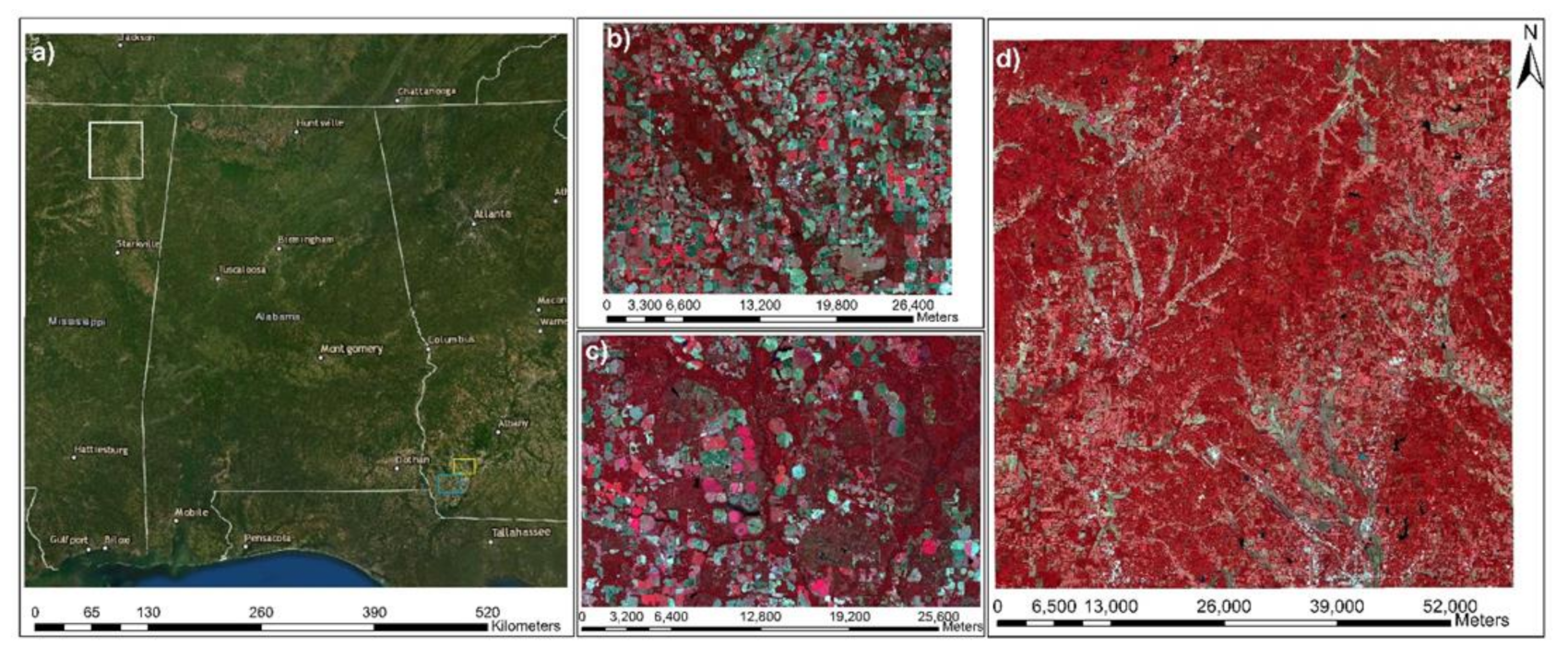
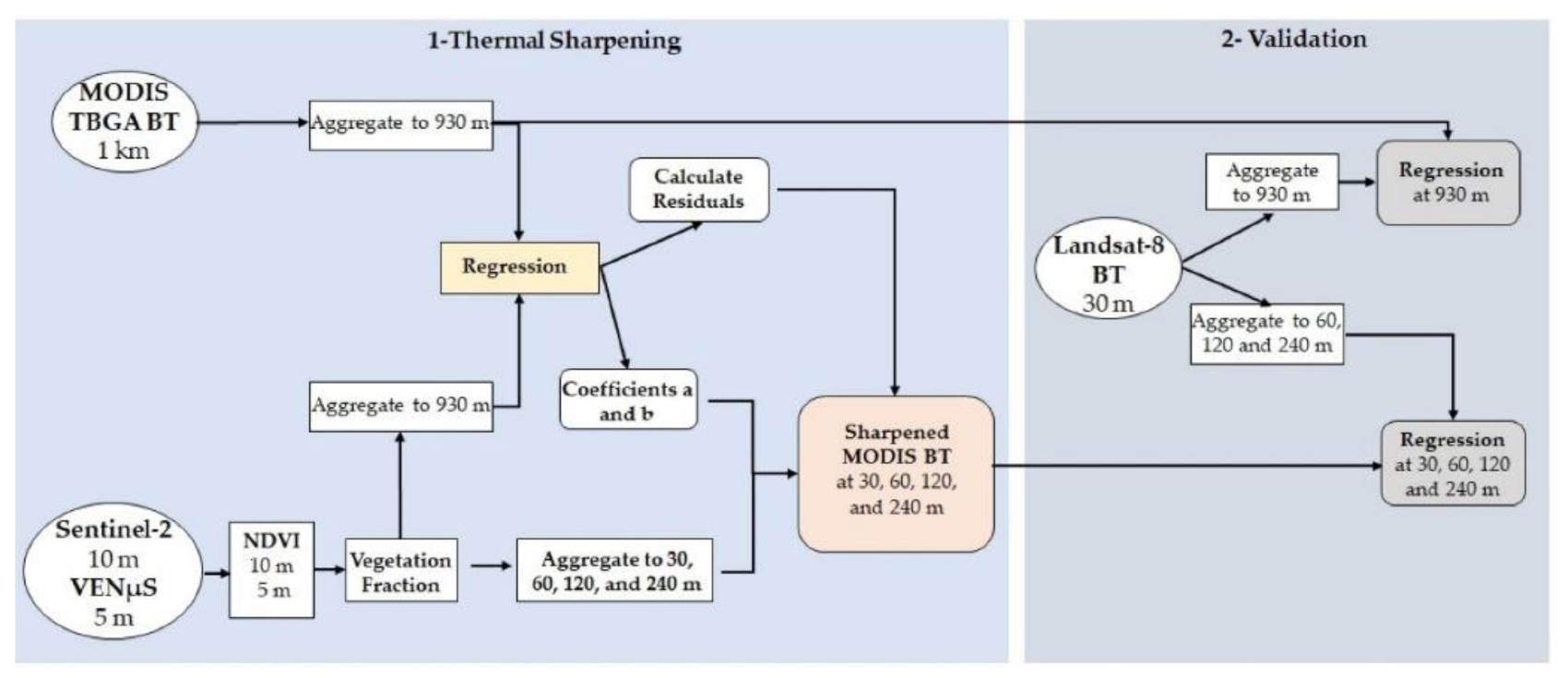
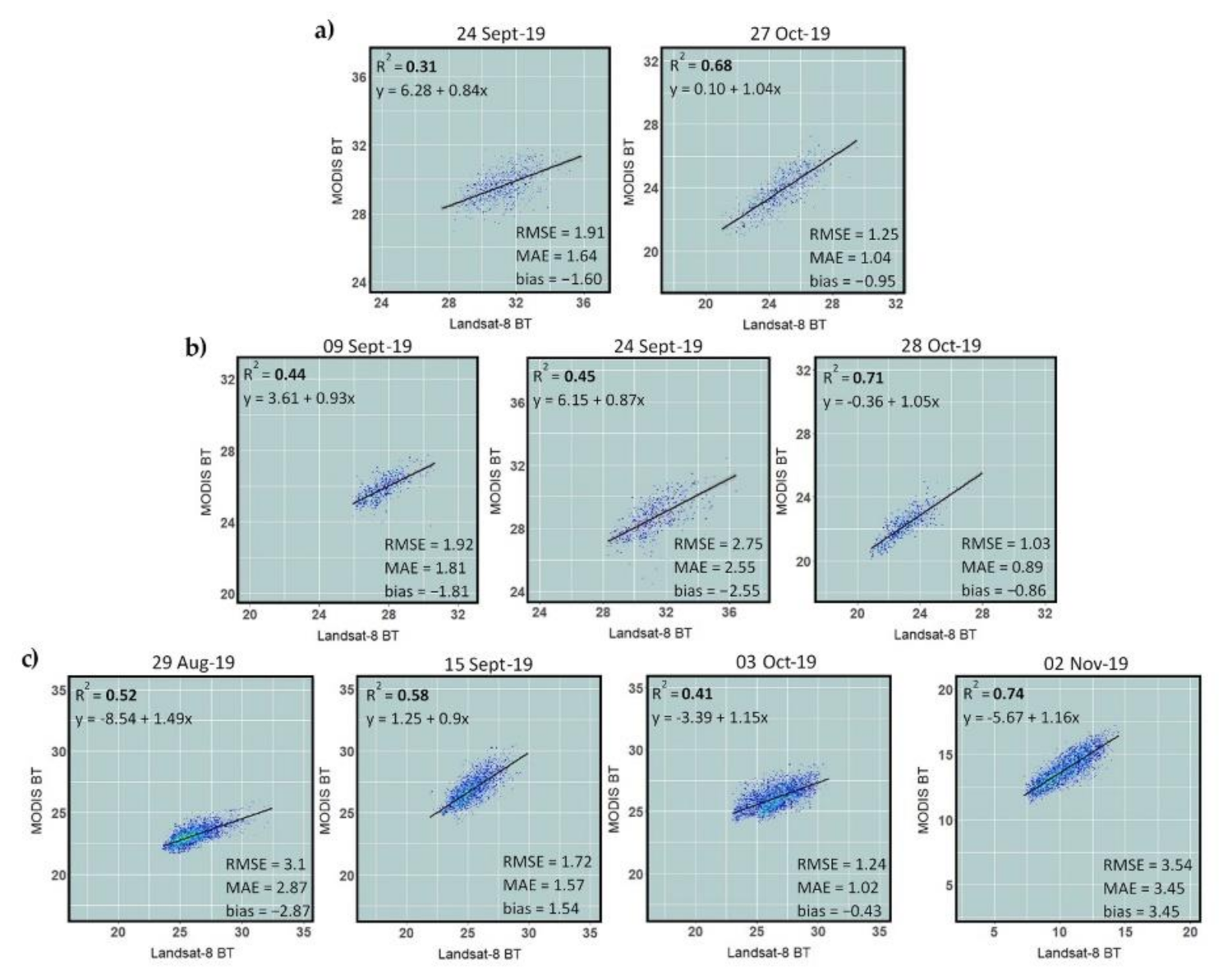
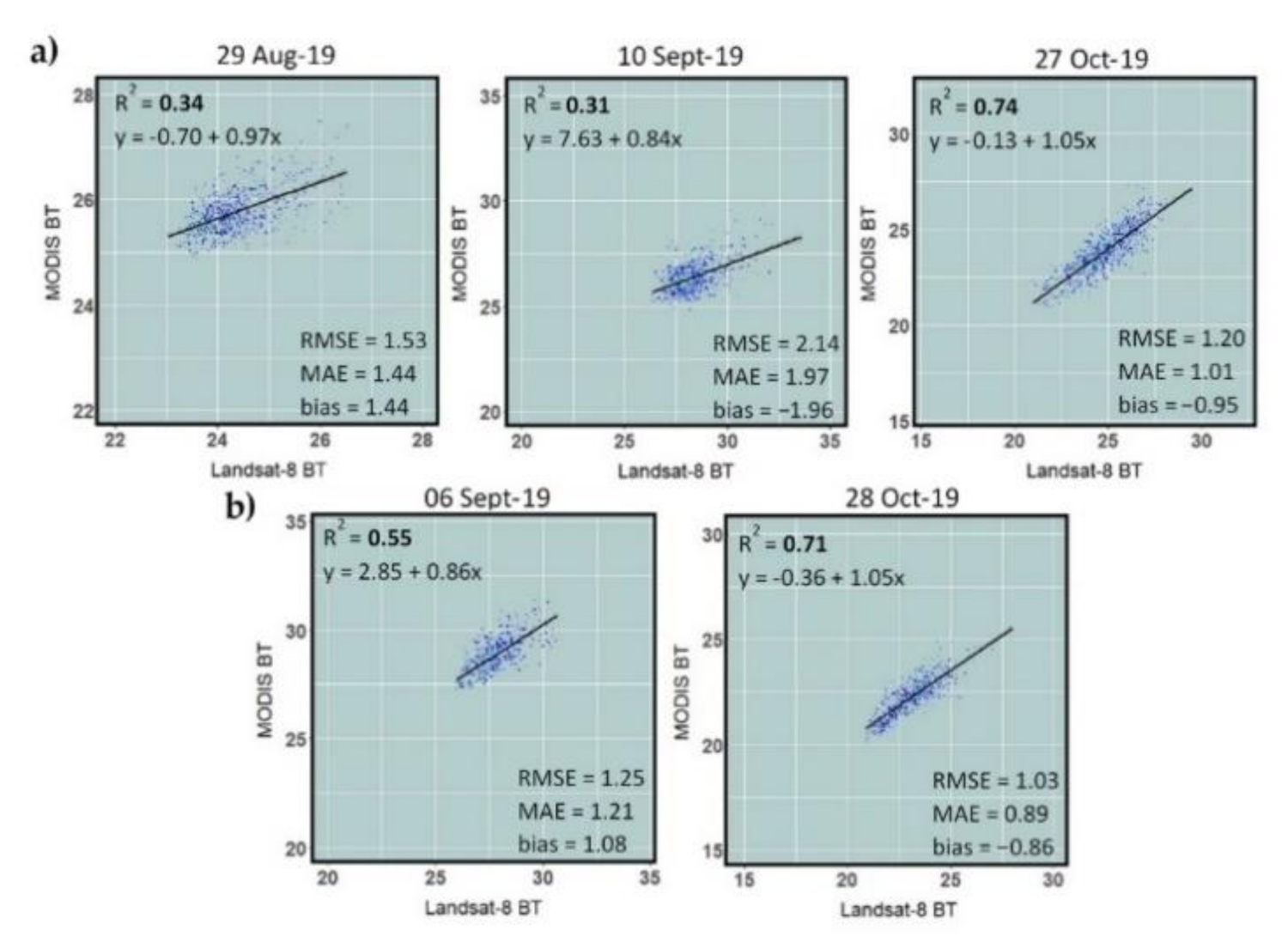
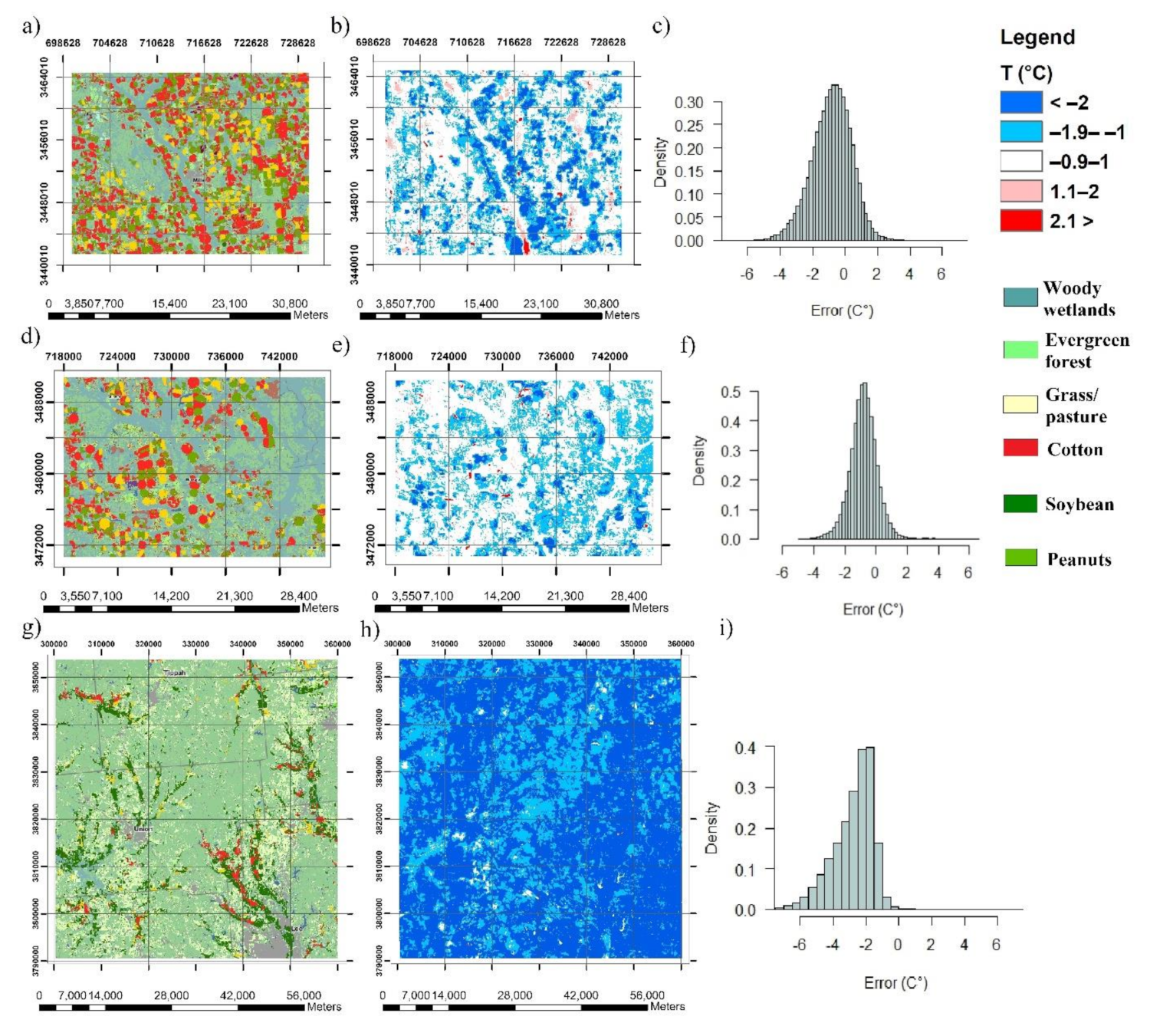
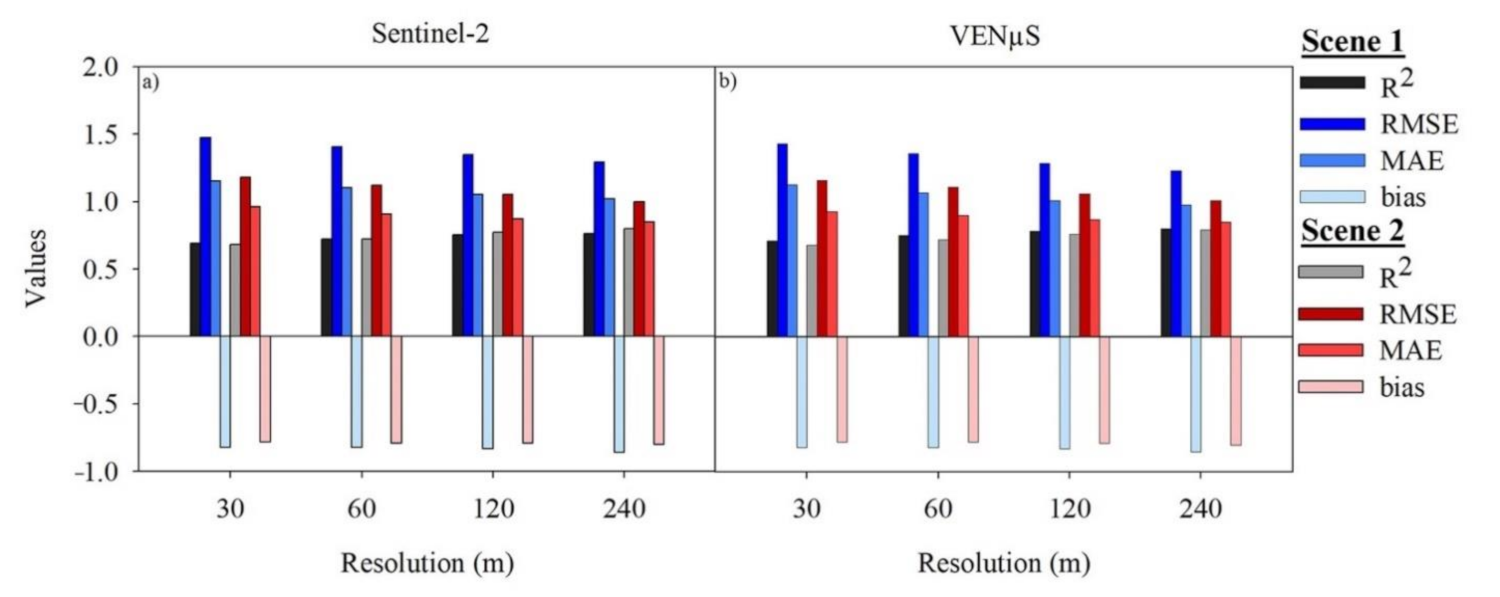
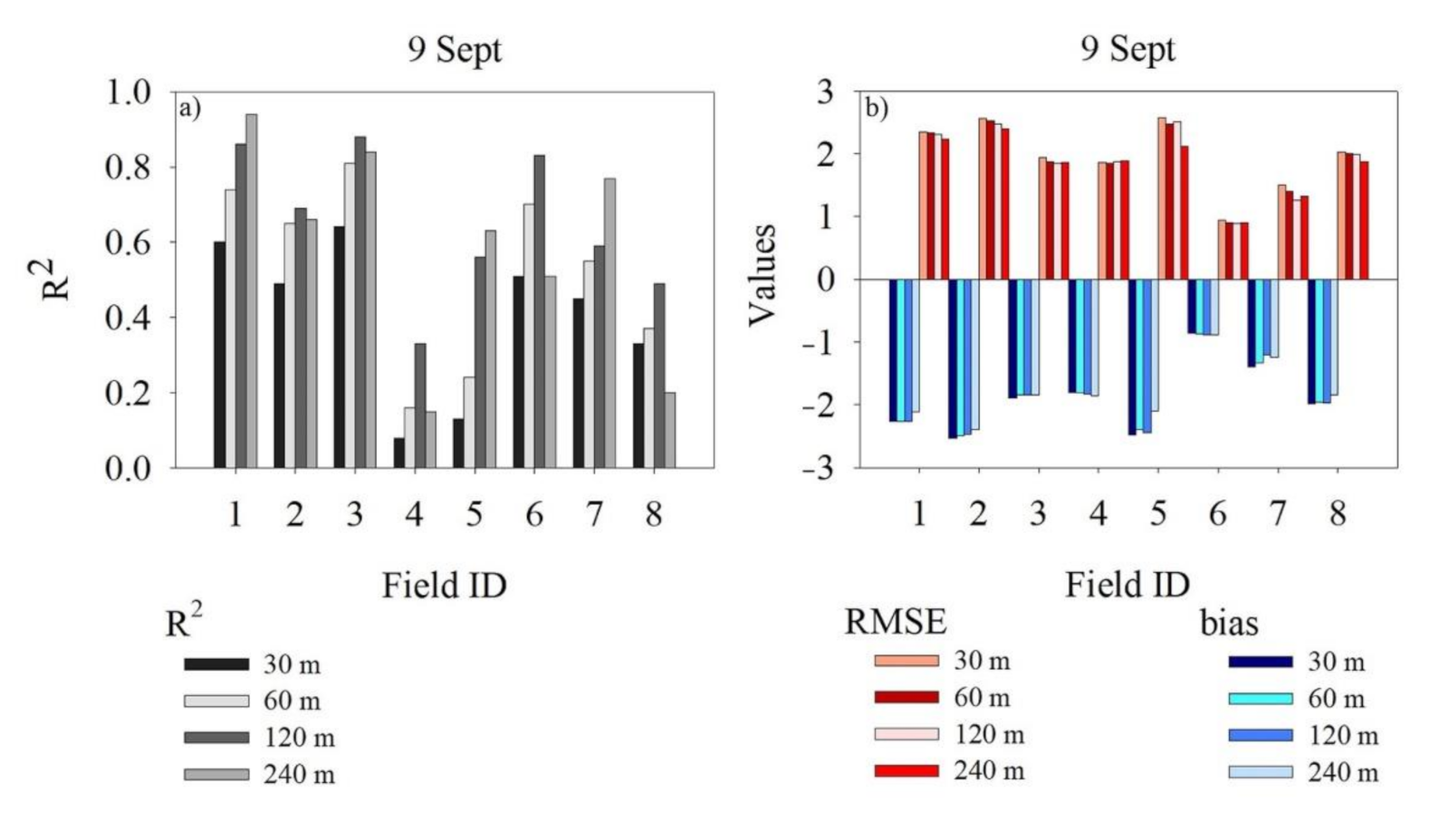
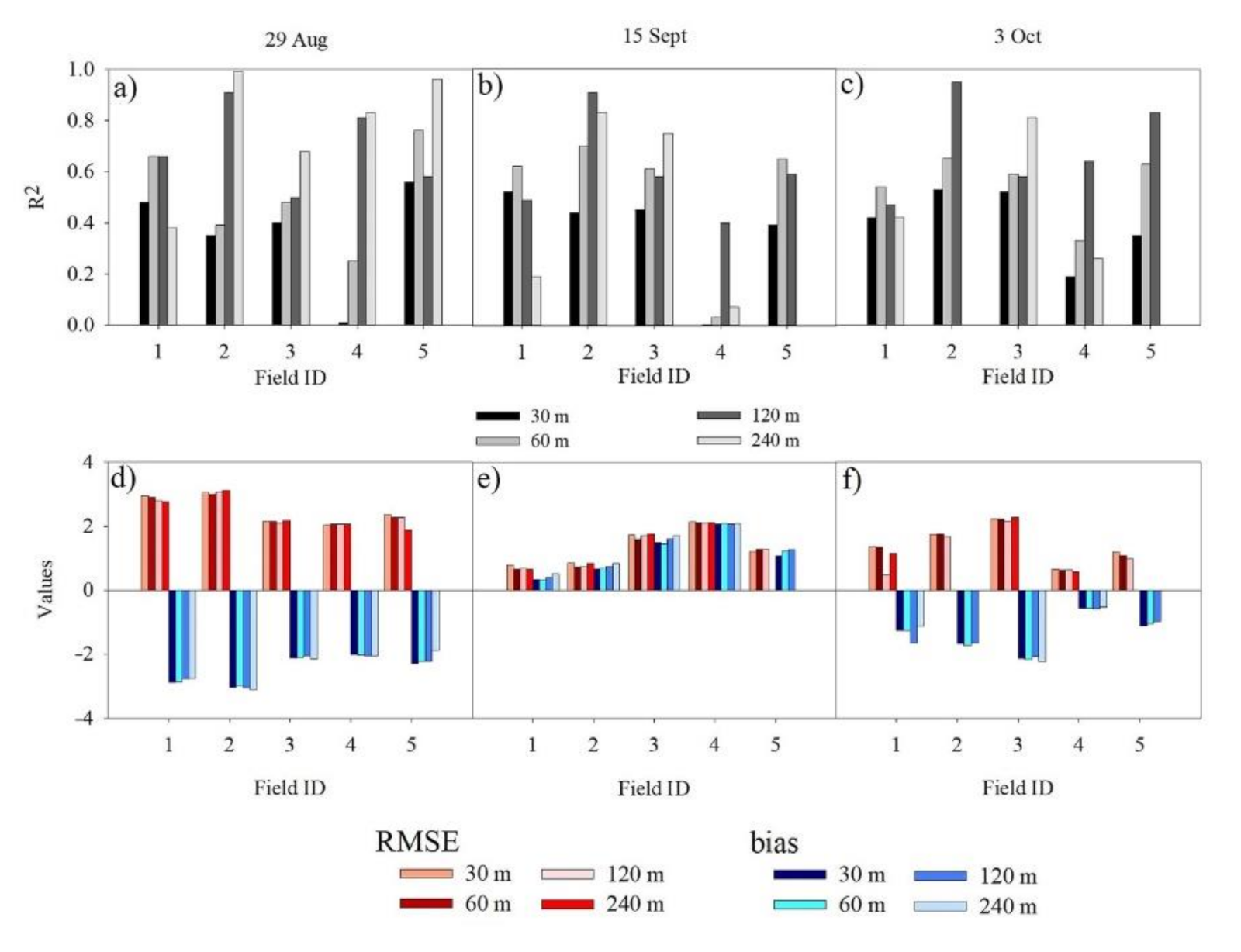
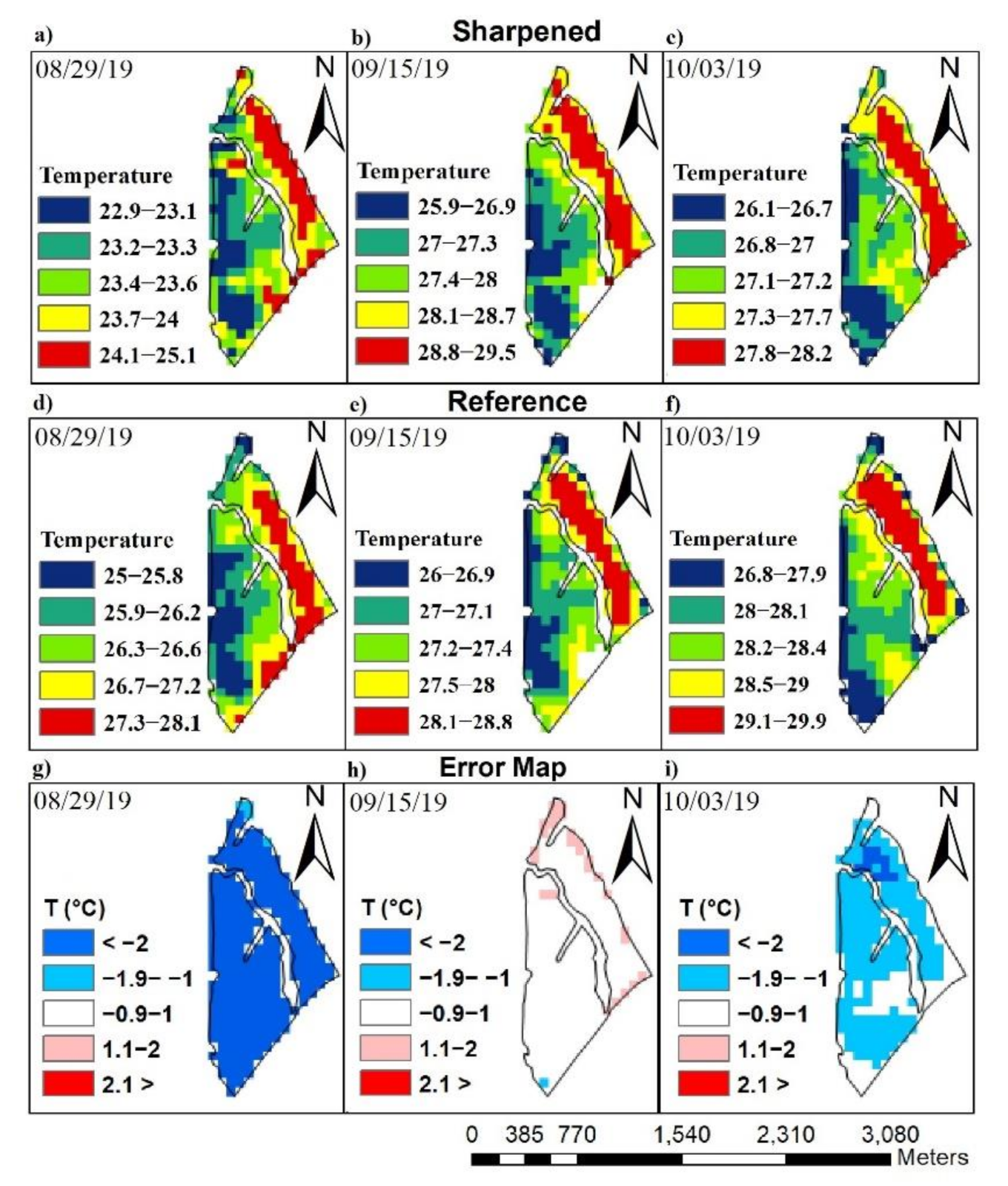
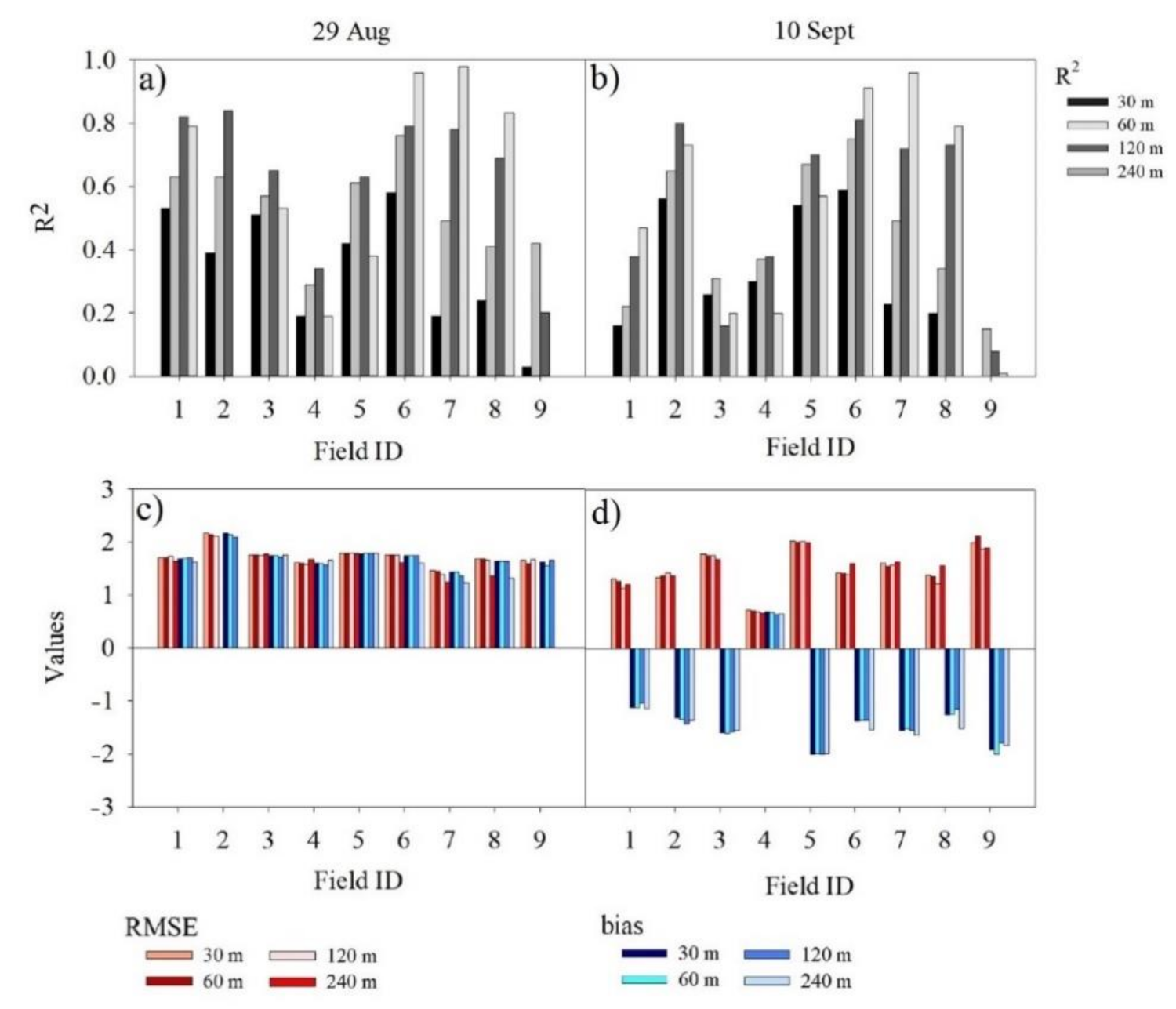
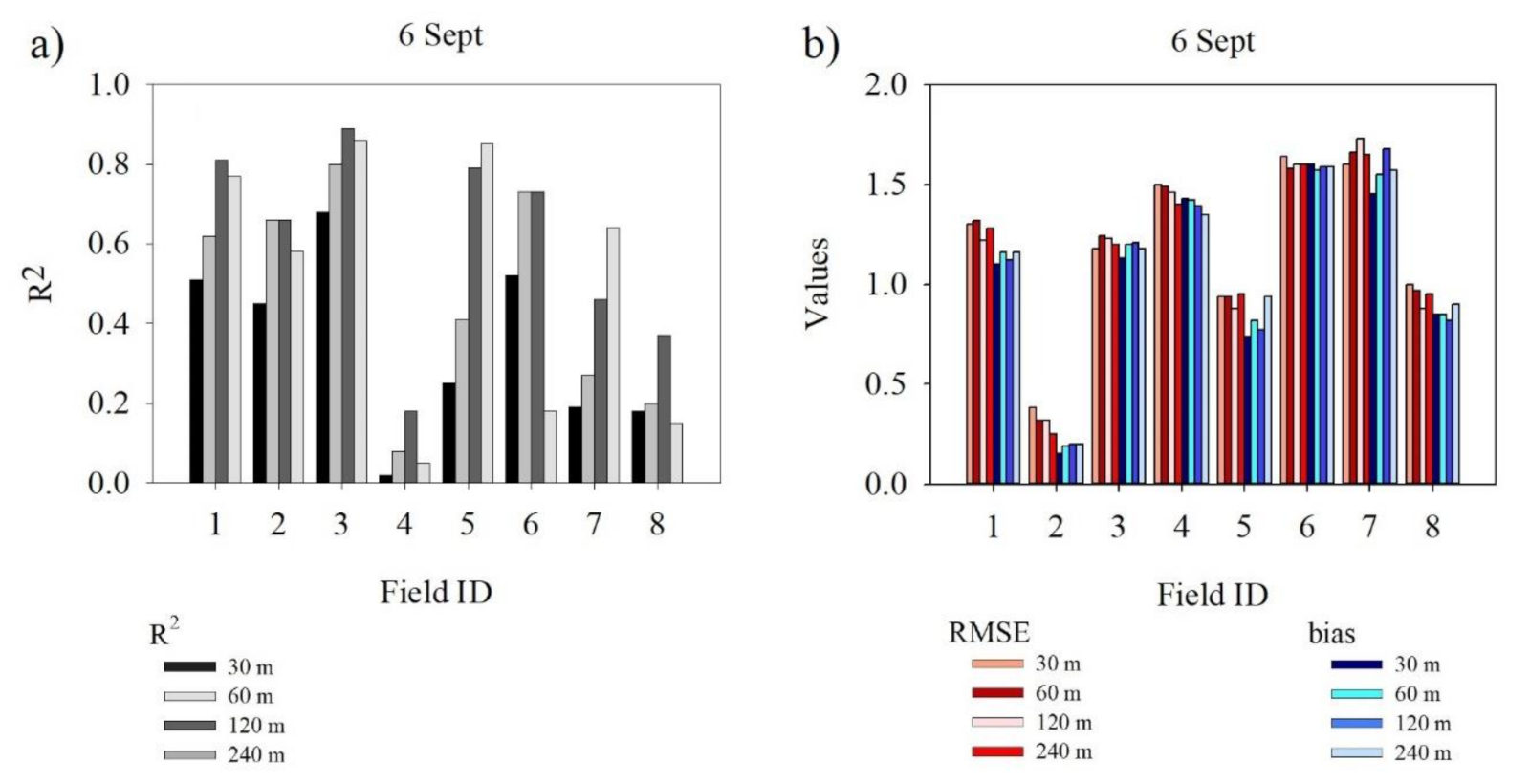
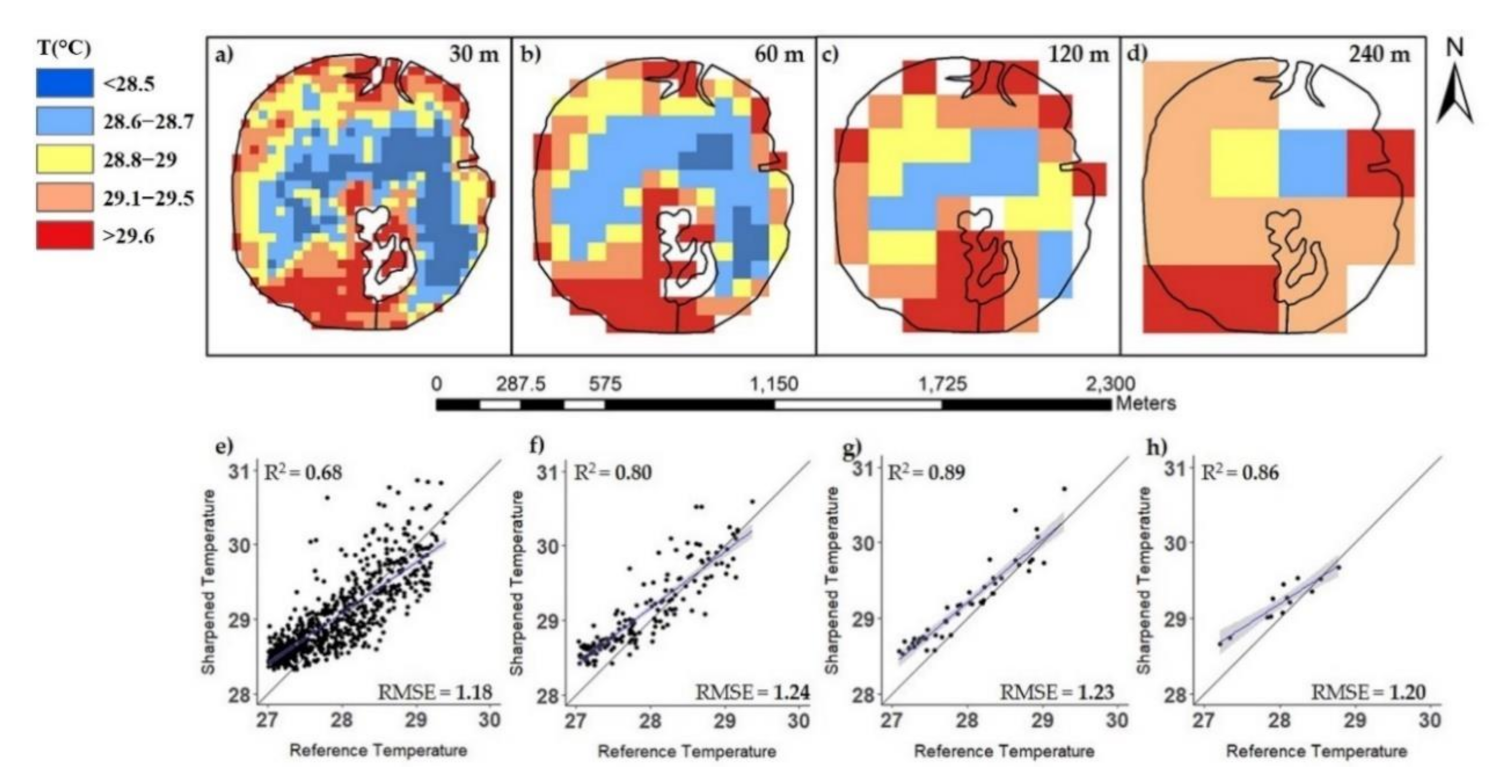

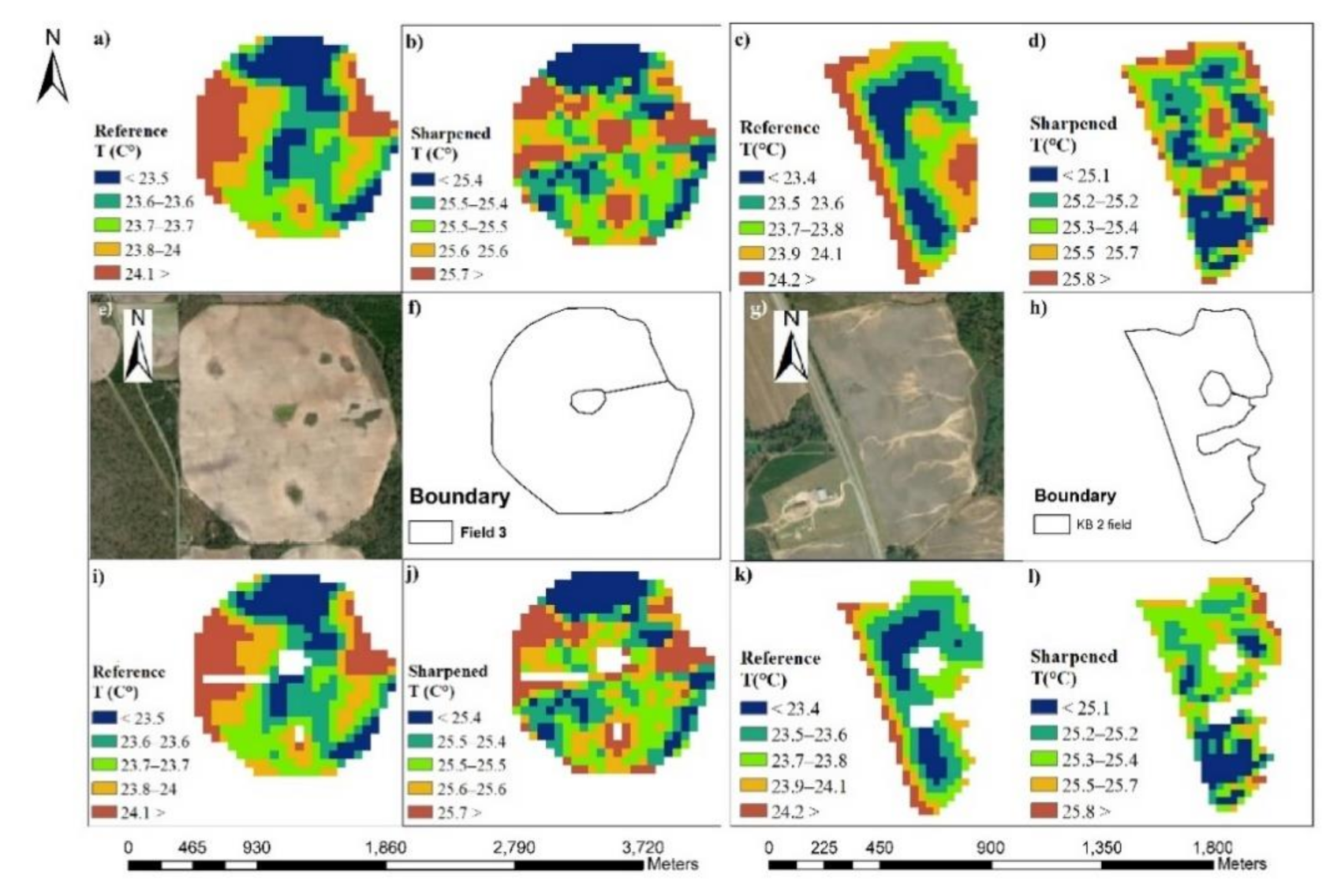
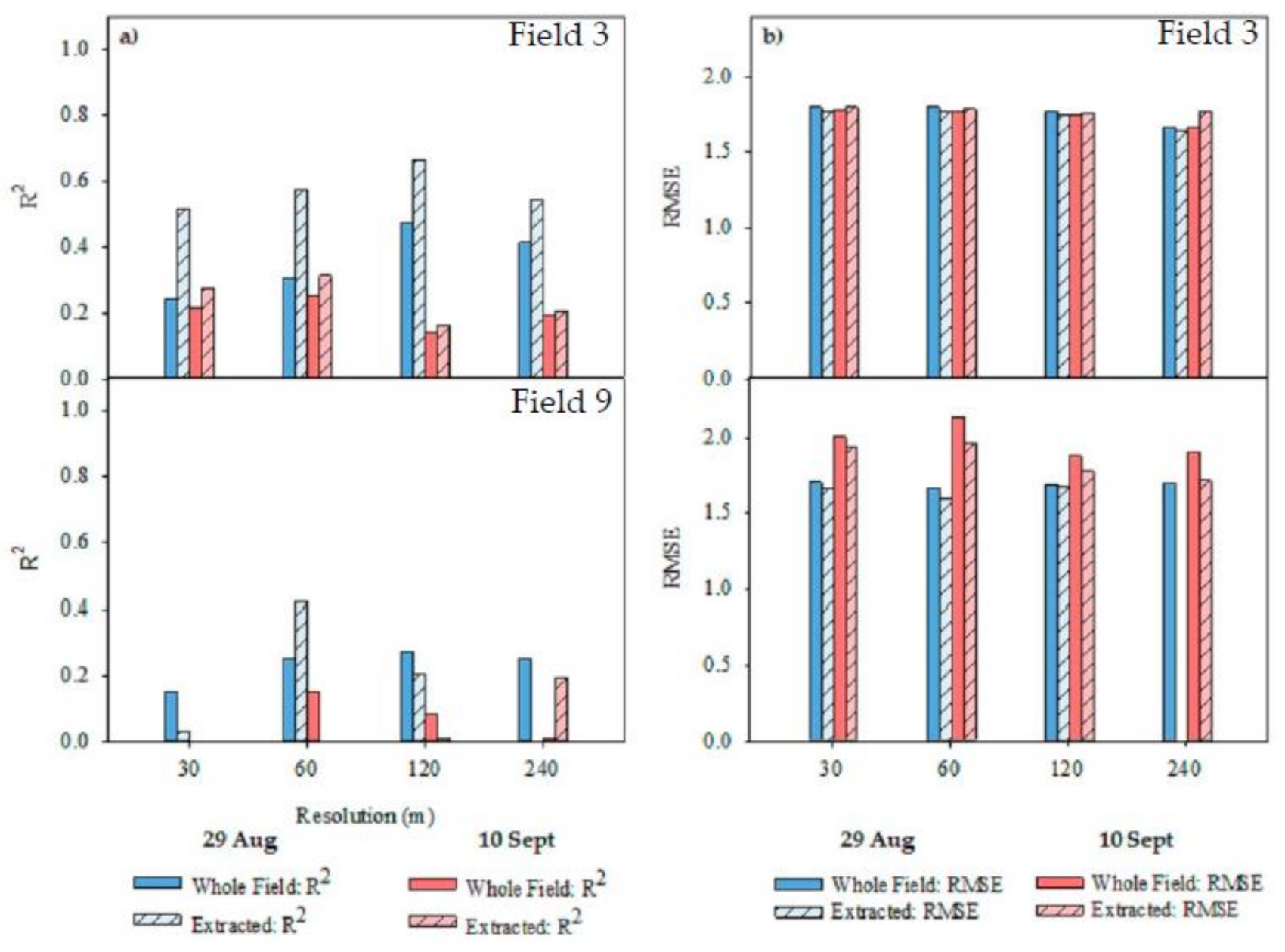
| Location | Landsat-8 | MODIS | Sentinel-2 | VENµS |
|---|---|---|---|---|
| Acquisition Date | ||||
| Miller County | 24 August 2019 | 29 August 2019 | - | 29 August 2019 |
| Georgia | 09 September 2019 | 10 September 2019 | - | 10 September 2019 |
| (scene 1) | 25 September 2019 | 24 September 2019 | 24 September 2019 | - |
| 27 October 2019 | 28 October 2019 | 27 October 2019 | 28 October 2019 | |
| -------------------- | ||||
| Baker County | 09 September 2019 | 6 September 2019 | - | 6 September 2019 |
| Georgia | 09 September 2019 | 09 September 2019 | 09 September 2019 | - |
| (scene 2) | 25 September 2019 | 24 September 2019 | 24 September 2019 | - |
| 27 October 2019 | 28 October 2019 | 27 October 2019 | 28 October 2019 | |
| -------------------- | ||||
| Union, County | 29 August 2019 | 29 August 2019 | 29 August 2019 | - |
| Mississippi | 14 September 2019 | 15 September 2019 | 15 September 2019 | - |
| (scene 3) | 30 September 2019 | 3 October 2019 | 3 October 2019 | - |
| 1 November 2019 | 2 November 2019 | 2 November 2019 | - | |
| Satellite | Location | MODIS | Landsat-8 | |||||||
|---|---|---|---|---|---|---|---|---|---|---|
| Date | Min | max | Range | Lag (days) | Date | min | max | Range | ||
| Sentinel-2 | Scene 1 | 24 Sept. | 27.0 | 31.9 | 4.9 | +1 | 25 Sept. | 27.6 | 35.9 | 8.3 |
| 28 Oct. | 21.0 | 27.2 | 6.2 | −1 | 27 Oct. | 21.0 | 29.5 | 8.5 | ||
| -------------------- | ||||||||||
| Scene 2 | 9 Sept. | 23.8 | 27.7 | 3.9 | 0 | 9 Sept. | 25.3 | 30.7 | 5.4 | |
| 24 Sept. | 24.5 | 32.4 | 7.9 | +1 | 25 Sept. | 28.3 | 36.4 | 8.1 | ||
| 28 Oct. | 20.1 | 25.0 | 4.9 | −1 | 27 Oct. | 20.9 | 28.2 | 7.3 | ||
| -------------------- | ||||||||||
| Scene 3 | 29 Aug. | 21.7 | 26.0 | 4.3 | 0 | 29 Aug. | 23.6 | 32.4 | 8.8 | |
| 15 Sept. | 24.2 | 30.5 | 6.3 | −1 | 14 Sept. | 21.9 | 29.9 | 8 | ||
| 3 Oct. | 24.1 | 28.8 | 4.7 | −3 | 30 Sept. | 23.0 | 30.9 | 7.9 | ||
| 2 Nov. | 11.2 | 17.2 | 6.0 | −1 | 1 Nov. | 7.3 | 14.5 | 7.2 | ||
| -------------------- | ||||||||||
| VENµS | Scene 1 | 29 Aug. | 24.9 | 27.5 | 2.6 | −5 | 24 Aug. | 23.0 | 26.5 | 3.5 |
| 10 Sept. | 24.9 | 29.9 | 5.0 | −1 | 9 Sept. | 26.3 | 33.6 | 7.3 | ||
| 28 Oct. | 21.0 | 27.4 | 6.4 | 0 | 27 Oct. | 21.0 | 29.5 | 8.5 | ||
| -------------------- | ||||||||||
| Scene 2 | 06 Sept. | 27.3 | 31.3 | 4.0 | +3 | 09 Sept. | 26.0 | 30.9 | 4.9 | |
| 28 Oct. | 20.1 | 25.0 | 4.9 | −1 | 27 Oct. | 20.9 | 28.0 | 7.1 | ||
| Scene | Date | Lag | Resolution | VENµS | ||||
|---|---|---|---|---|---|---|---|---|
| R2 | RMSE | MAE | bias | |||||
| 1 | 29 August 2019 | −5 | 30 | 0.48 | 1.70 | 1.57 | 1.48 | |
| 60 | 0.51 | 1.69 | 1.57 | 1.48 | ||||
| 120 | 0.52 | 1.67 | 1.56 | 1.48 | ||||
| 240 | 0.49 | 1.63 | 1.53 | 1.47 | ||||
| 10 September 2019 * | −1 | 30 | 0.52 | 2.37 | 2.12 | −2.09 | ||
| 60 | 0.54 | 2.31 | 2.07 | −2.03 | ||||
| 120 | 0.53 | 2.26 | 2.02 | −1.98 | ||||
| 240 | 0.49 | 2.20 | 1.98 | −1.94 | ||||
| 28 October 2019 | 0 | 30 | 0.71 | 1.43 | 1.13 | −0.82 | ||
| 60 | 0.75 | 1.36 | 1.07 | −0.82 | ||||
| 120 | 0.78 | 1.29 | 1.01 | −0.83 | ||||
| 240 | 0.80 | 1.23 | 0.98 | −0.85 | ||||
| -------------------- | ||||||||
| 2 | 6 September 2019 * | +3 | 30 | 0.59 | 1.46 | 1.22 | 1.14 | |
| 60 | 0.63 | 1.41 | 1.20 | 1.14 | ||||
| 120 | 0.66 | 1.37 | 1.19 | 1.14 | ||||
| 240 | 0.67 | 1.32 | 1.17 | 1.13 | ||||
| 28 October 2019 | −1 | 30 | 0.68 | 1.16 | 0.93 | −0.78 | ||
| 60 | 0.72 | 1.11 | 0.90 | −0.78 | ||||
| 120 | 0.76 | 1.06 | 0.87 | −0.79 | ||||
| 240 | 0.79 | 1.01 | 0.85 | −0.80 | ||||
| Scene | Date | Lag | Resolution | Sentinel-2 | ||||
|---|---|---|---|---|---|---|---|---|
| R2 | RMSE | MAE | Bias | |||||
| 1 | 24 September 2019 * | +1 | 30 | 0.55 | 2.14 | 1.71 | −1.44 | |
| 60 | 0.57 | 2.11 | 1.69 | −1.45 | ||||
| 120 | 0.58 | 2.07 | 1.66 | −1.45 | ||||
| 240 | 0.55 | 2.01 | 1.63 | −1.48 | ||||
| 28 October 2019 | −1 | 30 | 0.69 | 1.47 | 1.15 | −0.82 | ||
| 60 | 0.72 | 1.41 | 1.10 | −0.82 | ||||
| 120 | 0.75 | 1.35 | 1.05 | −0.83 | ||||
| 240 | 0.76 | 1.29 | 1.02 | −0.86 | ||||
| -------------------- | ||||||||
| 2 | 9 September 2019 * | 0 | 30 | 0.60 | 1.96 | 1.78 | −1.77 | |
| 60 | 0.64 | 1.94 | 1.77 | −1.77 | ||||
| 120 | 0.64 | 1.93 | 1.77 | −1.77 | ||||
| 240 | 0.63 | 1.91 | 1.78 | −1.77 | ||||
| 24 September 2019 | +1 | 30 | 0.56 | 2.81 | 2.49 | −2.43 | ||
| 60 | 0.59 | 2.77 | 2.49 | −2.43 | ||||
| 120 | 0.61 | 2.74 | 2.48 | −2.44 | ||||
| 240 | 0.61 | 2.71 | 2.48 | −2.46 | ||||
| 28 October 2019 | −1 | 30 | 0.68 | 1.18 | 0.96 | −0.78 | ||
| 60 | 0.72 | 1.12 | 0.91 | −0.79 | ||||
| 120 | 0.77 | 1.05 | 0.87 | −0.79 | ||||
| 240 | 0.80 | 1.00 | 0.85 | −0.80 | ||||
| -------------------- | ||||||||
| 3 | 29 August 2019 | 0 | 30 | 0.50 | 3.06 | 2.79 | −2.79 | |
| 60 | 0.55 | 3.05 | 2.79 | −2.79 | ||||
| 120 | 0.59 | 3.03 | 2.79 | −2.79 | ||||
| 240 | 0.60 | 3.02 | 2.81 | −2.81 | ||||
| 15 September 2019 * | −1 | 30 | 0.57 | 1.96 | 1.71 | 1.67 | ||
| 60 | 0.62 | 1.92 | 1.70 | 1.67 | ||||
| 120 | 0.64 | 1.87 | 1.68 | 1.65 | ||||
| 240 | 0.66 | 1.81 | 1.65 | 1.62 | ||||
| 3 October 2019 * | −3 | 30 | 0.45 | 1.45 | 1.15 | −0.52 | ||
| 60 | 0.48 | 1.43 | 1.13 | −0.50 | ||||
| 120 | 0.49 | 1.40 | 1.12 | −0.48 | ||||
| 240 | 0.48 | 1.35 | 1.09 | −0.45 | ||||
| 2 November 2019 | −1 | 30 | 0.64 | 3.85 | 3.67 | 3.67 | ||
| 60 | 0.69 | 3.82 | 3.66 | 3.66 | ||||
| 120 | 0.74 | 3.76 | 3.65 | 3.65 | ||||
| 240 | 0.77 | 3.71 | 3.61 | 3.61 | ||||
Publisher’s Note: MDPI stays neutral with regard to jurisdictional claims in published maps and institutional affiliations. |
© 2021 by the authors. Licensee MDPI, Basel, Switzerland. This article is an open access article distributed under the terms and conditions of the Creative Commons Attribution (CC BY) license (http://creativecommons.org/licenses/by/4.0/).
Share and Cite
Lacerda, L.N.; Cohen, Y.; Snider, J.; Huryna, H.; Liakos, V.; Vellidis, G. Field Scale Assessment of the TsHARP Technique for Thermal Sharpening of MODIS Satellite Images Using VENµS and Sentinel-2-Derived NDVI. Remote Sens. 2021, 13, 1155. https://doi.org/10.3390/rs13061155
Lacerda LN, Cohen Y, Snider J, Huryna H, Liakos V, Vellidis G. Field Scale Assessment of the TsHARP Technique for Thermal Sharpening of MODIS Satellite Images Using VENµS and Sentinel-2-Derived NDVI. Remote Sensing. 2021; 13(6):1155. https://doi.org/10.3390/rs13061155
Chicago/Turabian StyleLacerda, Lorena N., Yafit Cohen, John Snider, Hanna Huryna, Vasileios Liakos, and George Vellidis. 2021. "Field Scale Assessment of the TsHARP Technique for Thermal Sharpening of MODIS Satellite Images Using VENµS and Sentinel-2-Derived NDVI" Remote Sensing 13, no. 6: 1155. https://doi.org/10.3390/rs13061155
APA StyleLacerda, L. N., Cohen, Y., Snider, J., Huryna, H., Liakos, V., & Vellidis, G. (2021). Field Scale Assessment of the TsHARP Technique for Thermal Sharpening of MODIS Satellite Images Using VENµS and Sentinel-2-Derived NDVI. Remote Sensing, 13(6), 1155. https://doi.org/10.3390/rs13061155








